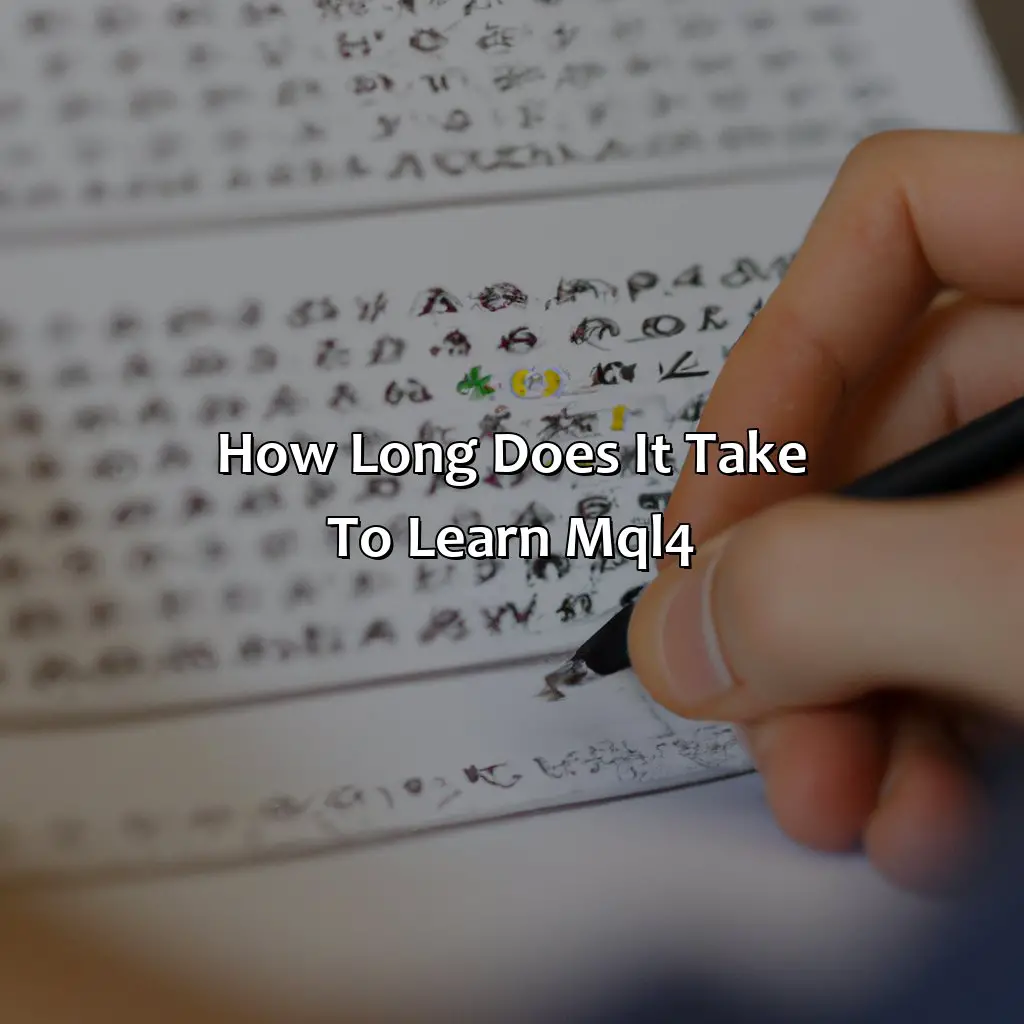
Key Takeaway:
- Learning MQL4 basics requires understanding the programming language and MetaTrader 4 platform’s functionality, focused on coding, syntax, functions, variables, trading automation, and data types.
- Intermediate concepts of MQL4 include analyzing backtesting, optimization, debugging, utilizing libraries and modules, and handling errors. Understanding technical analysis and trading strategies is crucial to developing profitable expert advisors and custom indicators.
- To implement machine learning, AI algorithms, and complex trading systems, advanced OOP concepts must be applied. Learning efficiently demands setting realistic goals, prioritizing essential concepts, following a structured learning plan, practicing consistently, and seeking help and feedback from experts and communities.
Understanding MQL4
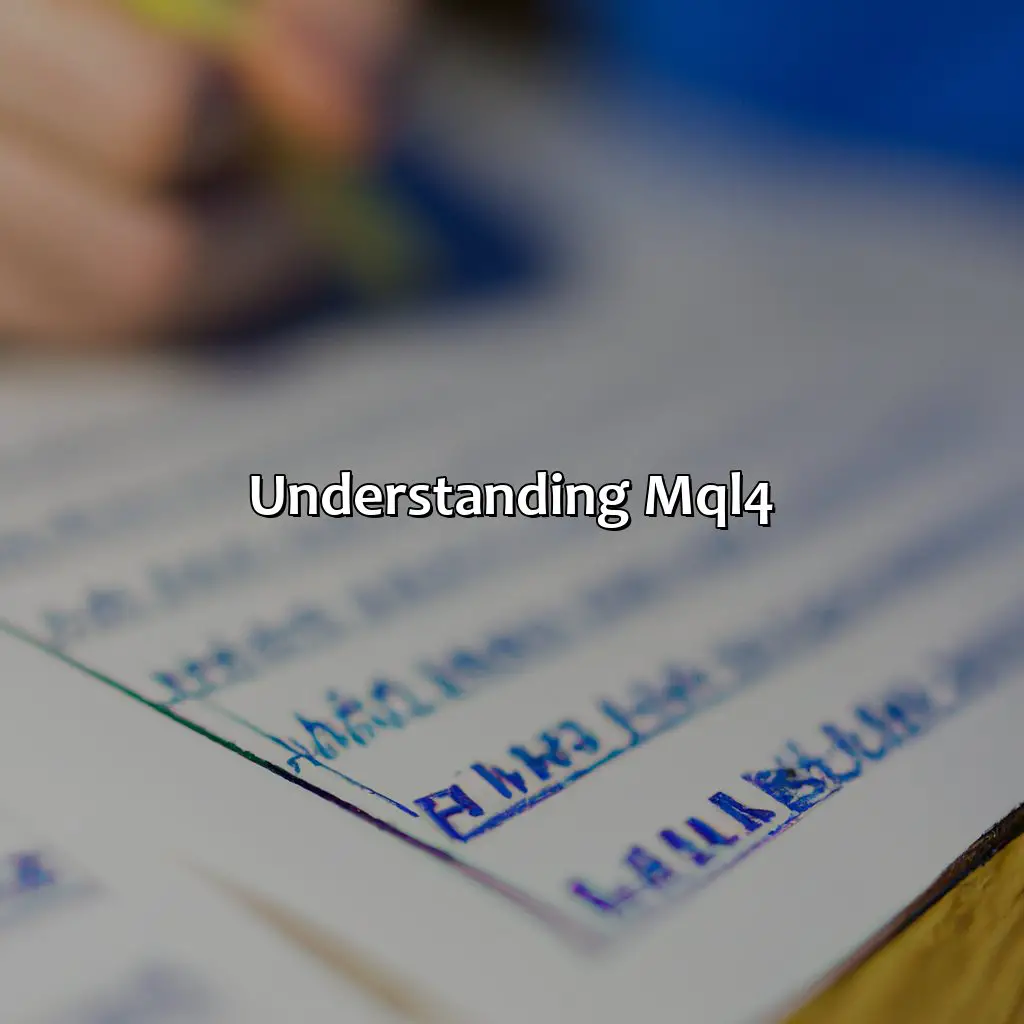
Photo Credits: forexbrokerreport.com by Russell Williams
MQL4 is a programming language that is used for creating automated trading strategies, indicators, and other custom tools that can be used in Metatrader 4.
Learning MQL4 is essential if one wants to start trading in the financial markets using automated trading systems. It is a powerful tool that enables traders to customize their trading strategies as per their requirements and enables them to execute trades automatically. MQL4 has a simple syntax structure which makes it easy and convenient for novice programmers to learn. The coding language also supports multiple functions that enable its users to create complex trading systems with ease.
Moreover, MQL4 helps traders to backtest their strategies and analyze their performance to improve their trading systems. By using MQL4, traders can monitor their trading strategies and manage their trades automatically, thus enhancing efficiency and reducing errors. MQL4 is an essential skill for aspiring traders who wish to use automated trading strategies in the financial markets.
A true fact is that MQL4 was developed by MetaQuotes Software Corp and was first introduced in 2005 with the release of Metatrader 4. It has since been widely adopted by traders and brokers worldwide.
Learning MQL4 Fundamentals
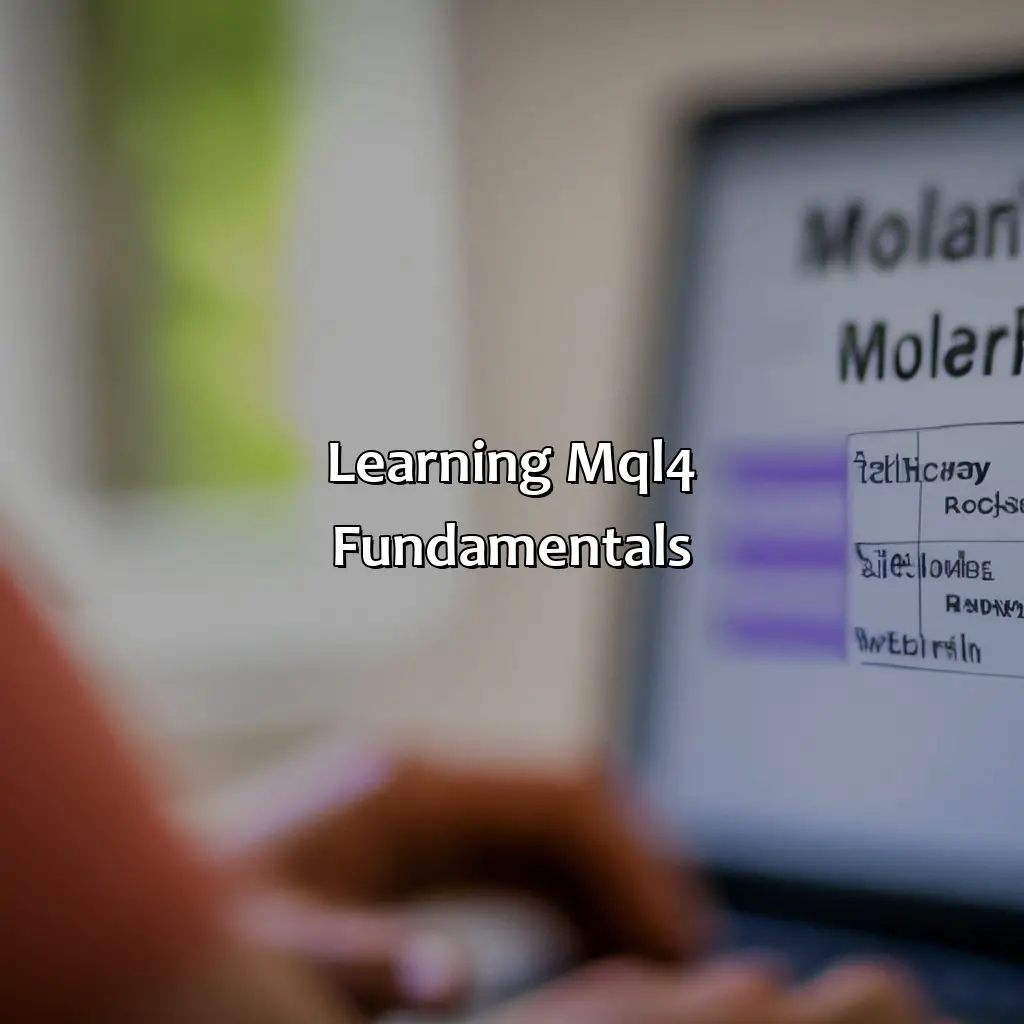
Photo Credits: forexbrokerreport.com by Patrick Clark
To master MQL4, you need to understand the syntax, functions and variables. So, start with the basics:
- Syntax
- Data types
- Operators and expressions
- Control structures
- Functions and variables
- Object-oriented programming
Learn these elements for an in-depth understanding of MQL4 programming.
Basic syntax and data types
The fundamentals of MQL4 involve understanding the syntax and data types used in writing code. The correct implementation of syntax is necessary to ensure the program executes as intended. Data types determine how information is stored, manipulated, and utilized in the program. It is essential to understand the various data types available and their appropriate use within the context of the program.
Additionally, mastering basic syntax and data types paves the way towards writing robust and efficient programs. It is crucial to follow language conventions when using programming languages. It helps avoid possible errors resulting from poor coding practices and ensures maintainability over time.
Working with MQL4 requires a high level of proficiency in properly utilizing syntax and data types to write optimal programs. Therefore, developers need to dedicate time to learning these concepts carefully.
Once an individual has adequately understood these fundamental concepts, they can dive into advanced features, such as libraries and modules that streamline processes significantly.
As aforementioned, acquiring full knowledge of basic syntax along with familiarity in working with datatypes forms a solid foundation for creating concrete trading systems as well as custom indicators. In summary, becoming proficient requires learning; consistency on applied knowledge will result in mastery.
Sharpen your mind and master MQL4 with ease, as we explore the fascinating world of operators and expressions.
Operators and expressions
The MQL4 language provides a wide variety of built-in operators and functions that can be used to manipulate data types such as integers, doubles, strings and arrays. It is essential for any programmer to have good knowledge of these concepts to effectively create algorithms using the MQL4 programming language.
Ensure that you understand operator precedence and associativity which specify which operator is evaluated first in the event of multiple operators being applied on an expression. It’s also vital to know the type conversion rules when applying operations on data types with varying data structures.
It is worth noting that poorly implemented operators or expressions can lead to irregular program behavior or produce irrelevant results. Stay up-to-date with user feedback regarding technical issues related to this concept before using it.
Don’t let your code run wild, tame it with control structures in MQL4.
Control structures
If-else statements are used to execute certain block of code when the condition is true or false respectively. Switch-case statements are kind of if-else statement but more suited when a value has multiple possibilities. Loops are used to repeatedly execute a block of code.
By using control structures, programmers have more control over the flow of their programs, allowing them to create complex logic and decision-making processes. Understanding these structures is crucial in developing efficient and effective MQL4 programs.
In addition to basic control structures, MQL4 also offers more advanced constructs such as break and continue statements as well as labelled loops. These features can be useful in creating more sophisticated programs.
Mastering control structures is essential for developing successful trading strategies using MQL4. Taking time to practice with examples can further improve one’s understanding and implementation of these constructs. Start practicing today so you don’t miss out on opportunities!
Mastering functions and variables in MQL4 is like having a toolbox full of different sized wrenches – you need the right ones to build a solid trading system.
Functions and variables
In MQL4, function and variable names must follow specific rules for syntax and naming conventions to prevent errors or conflicts. Functions can also accept parameters and return values depending on their implementation. They can also be used in combination with operators and expressions for more complex calculations.
Additionally, MQL4 offers a wide range of built-in functions and variables that can be leveraged to implement various trading strategies. It is crucial to understand the proper usage of these pre-defined functions to optimize program performance and avoid common pitfalls.
It takes time and consistent practice to master the use of functions and variables in MQL4 programming fully. According to a survey by Codecademy in 2020, it can take up to three months or more to learn the basics of programming languages like MQL4 with daily practice.
Get ready to dive into the world of OOP with MQL4, where programming concepts meet object-oriented design.
Object-oriented programming concepts
Object-oriented programming concepts in MQL4 involve the implementation of classes, objects, inheritance, and polymorphism to facilitate code reusability and modularity. By utilizing these principles, programmers can build complex trading systems with ease while maintaining the code structure.
The class defines the blueprint for creating objects that contain member variables and member functions. Inheritance enables a subclass to inherit properties and behaviors from its parent class, reducing redundant code writing. Meanwhile, polymorphism allows a program to use one object to represent different types of objects dynamically without knowing what specific object it is. This makes software development more efficient and less time-consuming.
It is essential to understand OOP concepts thoroughly before developing custom indicators or EAs, where code optimization is critical for better performance. Furthermore, OOP principles are relevant beyond just MQL4 programming since many programming languages incorporate them. Therefore, mastering OOP will be beneficial for programmers in their career.
Don’t miss out on acquiring OOP skills as they are essential in building robust trading systems and ensuring their extensibility and maintainability over time by enrolling in structured online courses or attending webinars to get an edge over your peers on your path towards coding excellence!
Unleash the power of MQL4 by mastering backtesting, optimization, debugging, technical analysis, and trading strategies through intermediate concepts.
Intermediate MQL4 Concepts
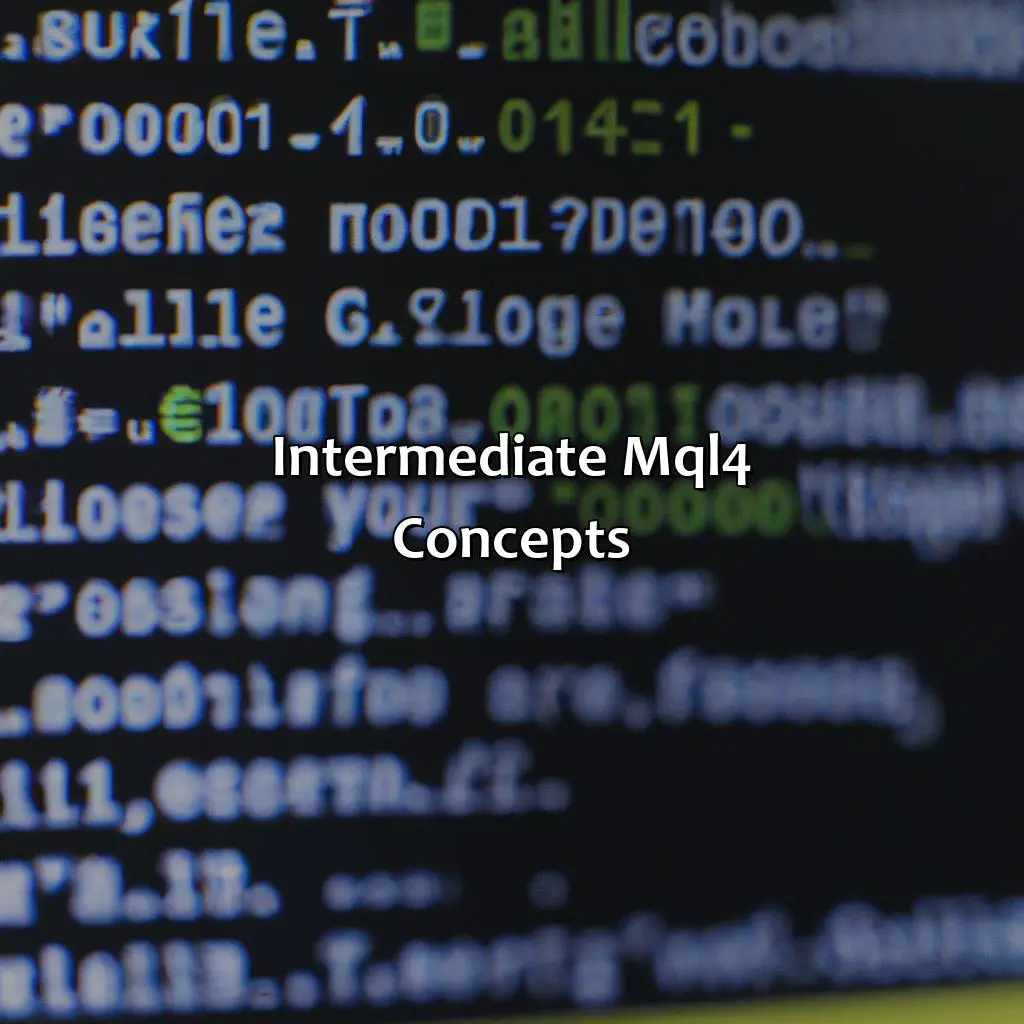
Photo Credits: forexbrokerreport.com by Philip Taylor
To master MQL4, get into Intermediate Concepts. This section – “Intermediate MQL4 Concepts” provides the answer. We will go over:
- Data arrays & structures for data management
- Using libraries & modules for better performance
- Error & debugging handling to cut mistakes
- Backtesting & optimization for smarter trading
Working with data arrays and structures
Working with arranged data and outlines is an essential concept when it comes to MQL4 programming. By processing large amounts of data efficiently, traders can extract insights from the market trends and make informed trading decisions. Here’s how you can work with data arrays and structures in MQL4:
- Understand the fundamental concepts of data arrays and structures
- Declare and initialize data arrays for storing information
- Create, access or modify elements in an array
- Use nested loops for performing operations on multi-dimensional arrays
- Define a structure that contains different types of variables or objects
- Accessor functions and operators for retrieving structure elements
To facilitate efficient programming, working with arranged data offers significant advantages to traders, such as holding massive amounts of information in memory. By understanding these concepts, traders can create complex trading systems that incorporate historical market prices while making informed future decisions.
When diving into MQL4 programming language, traders should prioritize the essential concepts like control structures, syntaxes first then move onto the intermediate ideas such as using modules, handling errors, and debugging. Finally, advanced concepts like machine learning algorithms should be prioritized.
For optimal progress while learning MQL4 Programming Language effectively- setting realistic achievable goals based on your proficiency level are essential. Following structured learning plans that involve solving practical problems consistently are beneficial. Seeking feedback from experts who have successfully implemented similar projects without plagiating or copying their code would further accelerate and refine skill development.
Boost your MQL4 prowess by tapping into the power of libraries and modules.
Using libraries and modules
The process of utilizing preexisting code in the MQL4 programming language can be achieved by incorporating libraries and modules. Libraries provide predefined functions and classes, while modules allow developers to encapsulate code into standalone units for easier integration. By utilizing libraries and modules developers can save time on coding, debug errors more proficiently and increase overall efficiency.
Libraries and Modules are an essential asset when developing expert advisors or custom indicators within the MQL4 programming language. Incorporating libraries reduces development time by allowing a developer to utilize already defined codes for a specific function, rather than having to write new code from scratch. An individual module encompasses specific functionality that can be added or modified with ease, reducing the risk of errors caused in other parts of the code.
It is crucial to understand when to use a library or module as both serve different purposes. Utilizing too many libraries can cause unnecessary overheads on deployment; meanwhile, using too little may lead to longer development times.
Pro Tip: Experimenting with various libraries and modules available opens up numerous possibilities for the developer to integrate complex functionalities into their trading strategies with ease.
Debugging code is like finding a needle in a haystack, but with enough patience and coffee, you’ll eventually find the culprit of those pesky errors.
Handling errors and debugging code
When programming in MQL4, encountering errors and bugs is not uncommon. Debugging code is a crucial skill to acquire as it helps identify and fix coding issues efficiently.
To handle errors and debugging code in MQL4 effectively, follow these steps:
- Use print statements: Printing out variables at specific points in the code can help narrow down the location of an error.
- Step through the code: Use debuggers to step through the code line by line and track variable values.
- Check function calls: Check function arguments for correct data types, scope, and syntax errors.
- Refer to documentation: Use official MQL4 documentation to understand error messages or explore functions that can resolve coding issues.
- Familiarize with common errors: Often, programming has typical mistakes. Understand common errors early on to fix them quickly.
- Seek help when needed: Collaborate with experienced programmers, post queries on forums or ask queries on Stack Overflow to learn from peers.
In addition to these steps above, testing code thoroughly after debugging also remains important.
A helpful resource includes “Expert Advisor Programming for MetaTrader 4” by Andrew R Young.
Backtesting and optimization: Making your trading strategy look good on paper before it disappoints you in real life.
Backtesting strategies and optimization
Backtesting and optimization are crucial aspects of MQL4 development, ensuring that trading strategies are based on accurate historical data and perform optimally in real-time market conditions. Below is a 4-step guide to effectively conduct backtesting and optimization in MQL4.
- Collect Relevant Historical Data: Choose relevant currency pairs, time frames, and market conditions for your backtesting period. Create a test plan that aligns with your strategy’s parameters.
- Conduct Backtesting: Use the MetaTrader 4 Strategy Tester to assess the performance of your code on historical data. Analyze results and refine code based on insights from the backtest.
- Optimize Parameters: Test different parameter combinations using the Optimization feature or advanced external software like Genetic Algorithms or Neural Networks. Find optimal values for risk levels, trade frequency, stops and targets, etc., then apply them to your system.
- Validate Results: Validate results by conducting forward testing on live trading accounts using very small positions or demo accounts before deploying real capital and closely monitor during live trading operations.
Besides, traders should also focus on keeping their testing methods robust, maintaining discipline in coding/research/testing processes over-time while avoiding overfitting, being aware of possible biases introduced by specific data sets, such as survivorship bias or liquidity bias.
In order to learn backtesting and optimization effectively within MQL4, one must prioritize essential concepts through structured learning plans to avoid frustration and burnout often associated with trial-and-error programming methodology which yields less productive results over time. Joining an online community/support group can aid condense learning time while boosting morale substantially over time resulting in higher-quality code with tangible benefits observed when deployed today via MT4 brokers across various markets internationally.
Take your MQL4 skills to the next level and create expert advisors, complex trading systems, and even AI algorithms with advanced concepts.
Advanced MQL4 Concepts
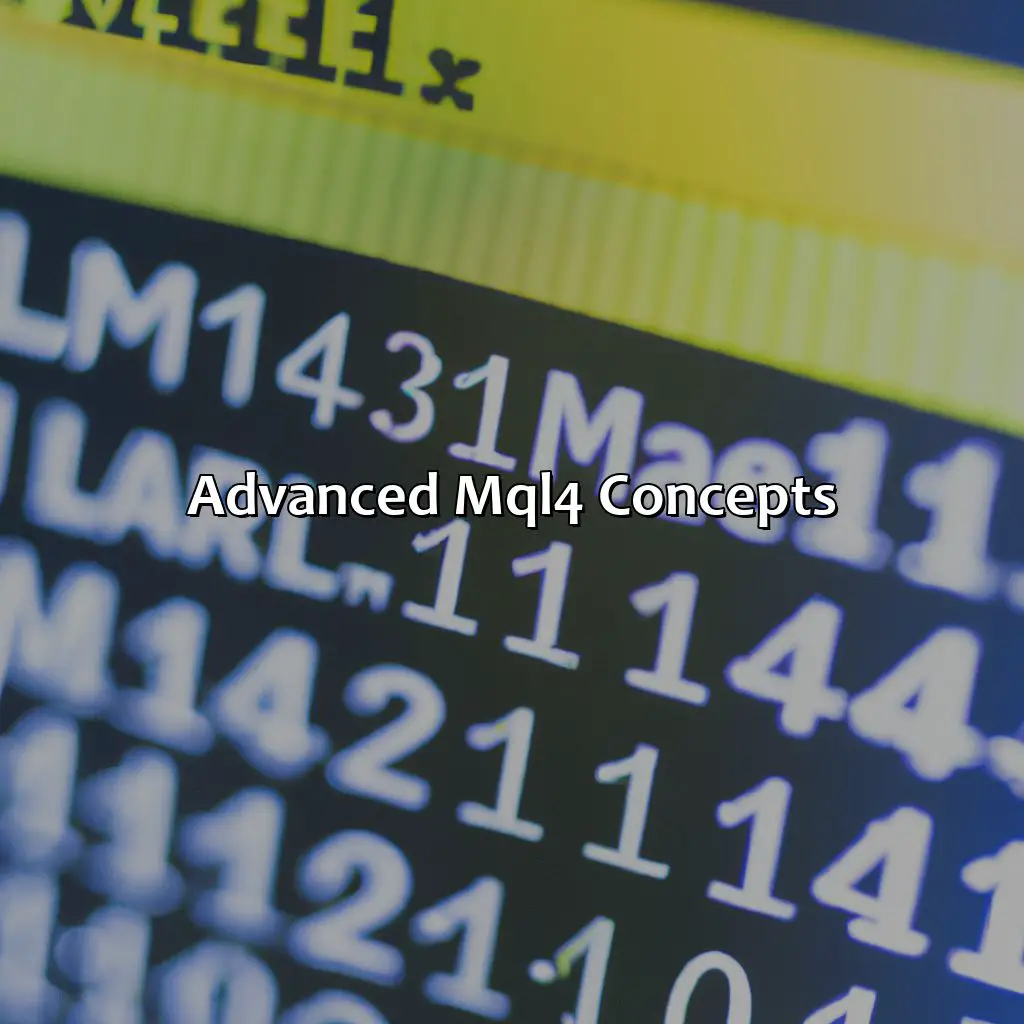
Photo Credits: forexbrokerreport.com by Richard Moore
To progress your MQL4 abilities, you must learn advanced ideas, such as constructing custom indicators and expert advisors (EAs), using object-oriented programming (OOP) and applying machine learning and AI algorithms.
This section on Advanced MQL4 Concepts will help you to understand these topics. It is divided into four sections that will guide you through each topic properly. Enhance your skills and accomplish your trading objectives with this guidance.
Developing custom indicators and expert advisors
Creating proprietary tools like customized indicators and expert advisors (EAs) is an essential skill for modern traders. By building EAs, traders can automate their trading strategies, improve accuracy, and increase efficiency. EAs operate according to predetermined parameters and execute trades automatically based on market conditions. This capability frees traders from having to monitor price fluctuations consistently.
Customized EAs also have several advantages over pre-existing commercial ones. For instance, these tools enable traders to create unique strategies tailored to their specific investment objectives. Another significant benefit is that custom EAs offer greater flexibility as they can integrate with various platforms and brokerages.
Developing custom indicators and expert advisors significantly requires advanced programming skills, typically honed through the systematic study of MQL4 fundamentals such as syntax, data types, control structures, libraries/modules, optimizing backtesting strategies, OOP concepts as well as understanding technical analysis trading.
To master these skills more effectively in a fraction of the time it would typically take via online training courses or relying on communities dedicated to coding languages becomes the norm amongst aspiring Forex/CFD dealers on its journey towards becoming a smart program trader. Seeking feedback from experts within these channels can further learners’ understanding while exposing them to new ideas or approaching a problem from different angles.
Augmenting one’s knowledge with consistent practice could further refine one’s code-writing capabilities supported by using user-friendly development systems such as the MetaEditor IDE or implementing “buy & sell” programs within predefined criteria sets that are taken into account based on harmonic patterns like ATR-based trailing stops and trend identification signals like Moving average crosses via MT4 platform or similar software packages available on reputable brokerage firms around AI/ML algorithms implementation.
Building complex trading systems in MQL4 requires the know-how of a rocket scientist and the patience of a saint.
Building complex trading systems
Developing intricate trading systems involves combining various coding concepts such as data arrays, libraries, error handling and machine learning algorithms. Optimum utilization of Object-oriented programming (OOP) concepts enables dynamic creation of expert advisors (EAs) and custom indicators. Building complex trading systems requires a good grasp of intermediate and advanced MQL4, making it essential to have a well-structured learning plan which entails consistent practice and seeking feedback from experts.
Pro Tip: Building complex trading systems require an in-depth knowledge of MQL4. Familiarize oneself with the fundamental concepts before embarking on advanced topics. When it comes to utilizing advanced OOP concepts in MQL4, the key is to think outside the function.
Utilizing advanced OOP concepts
Advanced OOP programming concepts involve utilizing design patterns, inheritance, and polymorphism to create efficient and adaptable trading systems. This involves understanding the principles behind object-oriented design, such as abstraction and encapsulation. By using these concepts, traders can build more complex strategies that are easier to maintain and update.
One unique aspect of advanced OOP programming is the ability to create reusable code modules that can be shared across different programs or projects. These modules can include custom classes and libraries that perform specific functions or calculations. In addition, developers can leverage third-party libraries to enhance their capabilities beyond what is provided in the MQL4 standard library.
In practice, advanced OOP concepts have been used successfully in trading systems that rely heavily on data analysis and machine learning algorithms. For example, one might use an OOP approach to design a neural network-based trading system that learns from historical data and adapts to changing market conditions.
True History: Many experienced traders have found success in designing advanced OOP programs for their trading needs. By leveraging these programming concepts, they are able to create more complex strategies that provide better risk management and higher returns. However, it takes time and effort to learn how to use these tools effectively – traders must be willing to invest the necessary resources into their education if they want to succeed in this field.
Get ready to teach your trading platform some new tricks with cutting-edge machine learning and AI algorithms.
Implementing machine learning and AI algorithms
Implementing advanced artificial intelligence algorithms with MQL4 has become increasingly popular in recent years. These sophisticated machine learning techniques can be utilized to create highly predictive trading models that can enhance the automation of arbitrage strategies based on specific datasets relevant to market trends. In practical terms, traders can leverage these algorithms and enhance their ability to identify profitable trades with a higher degree of accuracy and efficiency.
In addition, MQL4’s capacity to work seamlessly with AI programming languages such as Python and R is invaluable for those interested in deploying complex algorithmic strategies in multilevel system analysis approaches relating to a range of technical indicators. The integration between ML systems and expert advisors is quickly becoming an essential component of modern trading design architecture due to its high degree of flexibility and precision.
Several successful implementation examples illustrate the potential benefits of employing machine learning models alongside traditional trading systems based on rules-based methodologies. With evidence suggesting that such combinations have been able to outperform conventional asset allocation techniques based solely on fundamental analytics, it is clear that advanced AI applications are transforming the way traders analyze financial data in real-time.
According to MetaQuotes, the creators of MQL4, proficiency can be reached within a few months if one follows a structured learning plan consistently.
Learning MQL4 is a commitment, but with practice, mastery, self-motivation, and continuous improvement, you’ll be trading like a pro in no time.
Best Practices for Learning MQL4 Efficiently
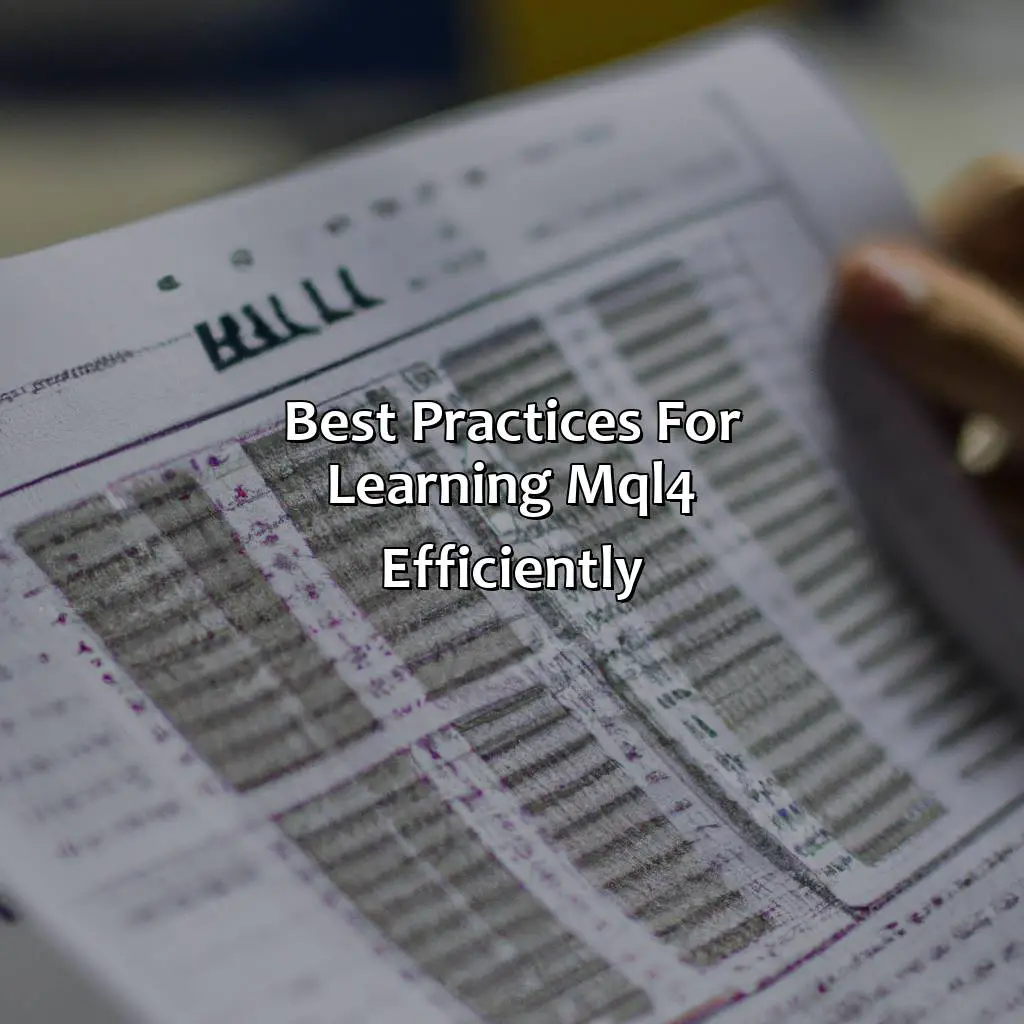
Photo Credits: forexbrokerreport.com by Robert King
Efficiently master MQL4 with these best practices:
- Set realistic goals.
- Prioritize essential concepts and skills.
- Follow a structured learning plan.
- Practice and apply knowledge regularly.
- Get help and feedback from experts and communities.
This decreases the time commitment and boosts self-motivation for continual improvement in MQL4.
Setting realistic goals and expectations
To learn MQL4 efficiently, it is crucial to set practical goals and expectations. Unrealistic targets can lead to frustration and a lack of motivation. Instead, establish achievable milestones that will keep you on track towards your ultimate goal.
By setting realistic goals and expectations, you can prioritize what’s necessary to learn. Consider starting with the fundamental concepts before diving into more advanced ones. Make sure to pace yourself and avoid overwhelming yourself with too much information at once.
Furthermore, following a structured learning plan can also help manage your expectations. By breaking down complex topics into smaller pieces, it becomes easier to grasp and apply new knowledge effectively.
Interestingly, several successful traders have shared their experiences regarding the importance of setting practical objectives when learning MQL4. It takes time and dedication to become a proficient programmer in this field.
In summary, to learn MQL4 efficiently, one must set achievable objectives in terms of realistic goals and expectations. Prioritize essential concepts, follow a structured learning plan, practice consistently and seek help from experts when needed—this approach increases your chances of achieving your desired outcome quickly.
Get ahead of the game by focusing on the essential concepts and skills of MQL4.
Prioritizing essential concepts and skills
A crucial aspect of efficiently learning MQL4 is prioritizing the acquisition of essential concepts and skills in a structured manner. Understanding basic syntax, data types, operators, expressions, control structures, functions, and variables are some essential building blocks. Additionally, acquiring intermediate-level competencies such as working with data arrays and structures, using libraries and modules error handling & debugging code and backtesting strategies are also critical skills.
Furthermore, neglecting to concentrate on these essential concepts may cause learners to struggle further along the learning curve when more complex concepts emerge. For instance, advanced topics like developing custom indicators and EAs require a strong foundation of the basics.
Moreover, prioritizing essential concepts leads to more efficient retention of information while avoiding wasted time on less critical tasks. Focusing on crucial learning objectives enables the learner to progress at their optimal speed as they acquire new skills.
Historically in financial technology (fintech), traders learned most programming languages themselves before increasing access to formal education for programming languages became commonplace. The trend is shifting towards self-taught methods through proper course materials published by experienced trainers who have worked with fintech innovations for years while emphasizing mastering essential concepts in structured settings.
Building a solid foundation with a structured learning plan is the key to unlocking the full potential of MQL4.
Following a structured learning plan
Developing a systematic approach is crucial when learning MQL4. This involves creating and following a structured learning plan to ensure that essential concepts and skills are prioritized and mastered efficiently. A structured learning plan can comprise various activities such as reading documentation, watching tutorials, completing interactive exercises, and solving coding challenges to apply knowledge consistently.
In addition to following the structured learning plan, it’s essential to monitor progress systematically. The learner’s goals should be clear and regularly reviewed to evaluate their performance against these objectives. Keeping track of any difficulties faced by individuals while working on MQL4 will help them focus precisely on the areas that require improvement.
Aside from self-study materials, experts in trading communities or forums can offer valuable tips, guidance and feedback while working on projects related to MQL4. Active participation in community discussions/forums enables learners to develop networking connections that could come in handy when experiencing technical difficulties.
An excellent example of how following a structured learning plan has effective results is the story of Richard Pedersen. Richard fully embraced MQL4 after attending an invaluable workshop which taught him how important it was to create a structured personal development schedule; he began by dedicating hours specifically for studying the theoretical aspects of programming languages then proceeded with practical implementations using backtesting simulations before application into live market accounts. The result? In less than six months, he developed his custom-made EA that boiled down market-relevant data analyses which eventually gained significant returns impressively despite overall market volatility during those times!
Consistency is key to mastering MQL4; practice smart, not hard, and apply your knowledge consistently for optimal results.
Practicing and applying knowledge consistently
To achieve mastery of MQL4, consistent practice and application of knowledge is essential. It is a gradual process, but with determination and hard work, one can make significant progress.
Here’s a five-step guide to consistently practicing and applying knowledge:
- Create a consistent learning routine that fits your schedule.
- Break down concepts into manageable parts and set achievable goals.
- Use various resources like reading materials, videos, and tutorials to reinforce your understanding of concepts.
- Apply the concepts in real-world scenarios through backtesting or creating simple scripts to automate trading strategies.
- Consistently seek feedback and help from experts or online communities to improve your skills constantly.
It’s crucial to avoid procrastination by committing yourself to short but meaningful sessions regularly. Additionally, setting realistic goals helps you track your progress more effectively.
By implementing the above steps with discipline, consistent practice and applying knowledge will become second nature.
Seeking help and feedback from experts and communities
In developing MQL4 skills, expert help and feedback from the community is fundamental. Interacting with experts helps to clarify misunderstandings and perfect algorithms. Additionally, seeking feedback offers insights in identifying weaknesses and areas of improvement.
Considering the complex nature of coding, collaborating with others who have similar interests or face similar challenges fosters a supportive learning environment that promotes growth. Diverse experiences provide different perspectives that broaden knowledge on best practices and effective do’s and don’ts for MQL4 development.
Moreover, learning environments such as forums and groups offer a platform for discussions on specific topics within MQL4 development. These online communities offer practical problem-solving techniques, advice on effective strategies, as well as technical reviews aiming at improving codes. Interacting in these ecosystems opens up opportunities to meet developers from various backgrounds with diverse expertise.
Therefore, amplifying efforts in seeking guidance from experts and active participation in communities equips learners with practical skills necessary to become successful coders in MQL4 development. Failing to do so potentiates missed growth opportunities due to limited perspectives.
Don’t miss out on maximizing your potential by engaging with other MQL4 developers today!
Five Facts About Learning MQL4:
- ✅ MQL4 is a programming language used for developing trading robots and technical indicators in MetaTrader 4. (Source: Admiral Markets)
- ✅ The time it takes to learn MQL4 depends on the individual’s prior programming experience and dedication to learning. (Source: MQL5)
- ✅ The official MQL4 documentation and community forums provide extensive resources for learning the language. (Source: MetaQuotes)
- ✅ Online courses and tutorials on platforms like Udemy and YouTube can also aid in learning MQL4. (Source: Trading Heroes)
- ✅ Mastery of MQL4 can lead to the development of profitable trading strategies and financial independence. (Source: Earn2Trade)
FAQs about How Long Does It Take To Learn Mql4?
How long does it take to learn MQL4?
Learning MQL4 can take anywhere from a few weeks to several months, depending on the learner’s experience with programming, dedication, and the complexity of the project. It is essential to have a good understanding of programming fundamentals and the MT4 platform to be successful in MQL4.
What is the difference between MQL4 and MQL5?
MQL4 and MQL5 are two different programming languages used for developing expert advisors, indicators, and scripts for MT4 and MT5 trading platforms, respectively. While MQL4 is a procedural language, MQL5 is an object-oriented language, making it more robust, flexible, and easier to work with multi-threading, for loop, and multi-dimensional arrays.
Where can I find codebase material for MQL4?
The MT4 codebase is a repository of MQL4 algorithms shared by developers worldwide. You can access it through the MT4 terminal or the official MQL4 website. You can browse codes, download, and use them as templates for building your custom expert advisors and indicators.
What are the checks and error reporting in MQL4?
Checks and error reporting are essential features in MQL4 that help detect and troubleshoot bugs or errors in your program. The functions used for this purpose include Alert, Comment, Print, and SendMail. Proper usage of these functions can save you time and resources when debugging your code.
Can I use MQL4 on cTrader?
No, cTrader uses the cAlgo language for programming, which is different from MQL4. However, some concepts like multi-currency trading and history database are similar between the two platforms.
Are there free trading apps and Forex VPS for MQL4 developers?
Yes, there are several free trading apps and Forex VPS services available online for MQL4 developers. Trading apps include MT4 Supreme Edition, MT4 WebTrader, and MT4 mobile apps. VPS services include Amazon Web Services, Google Cloud Platform, and Vultr VPS hosting.

